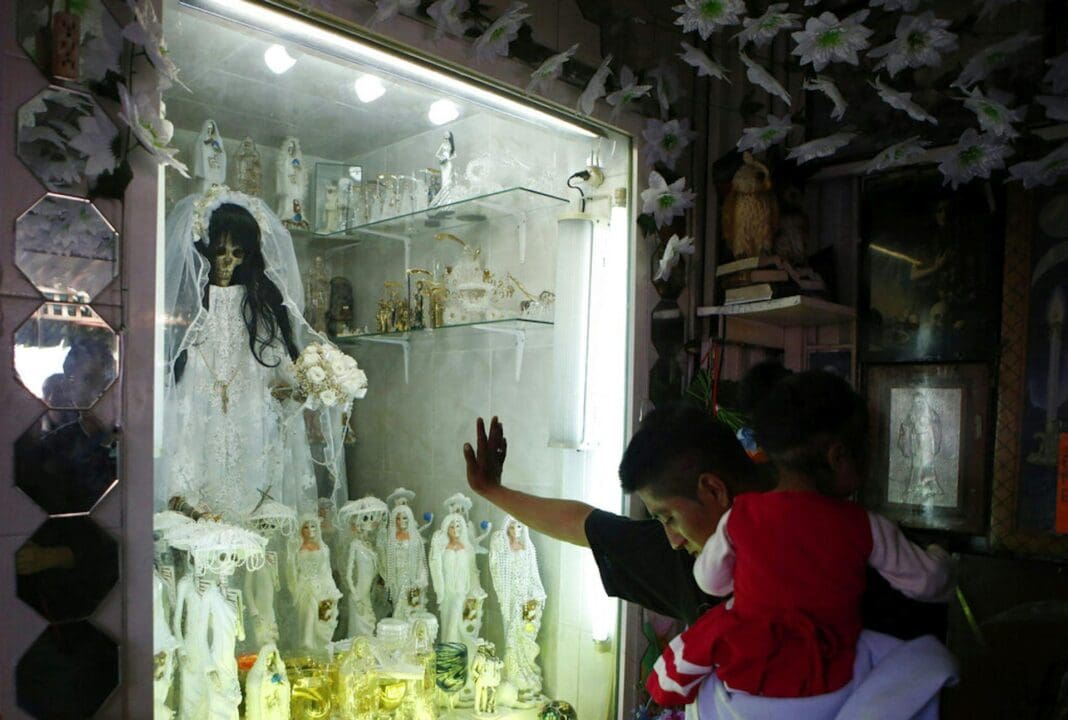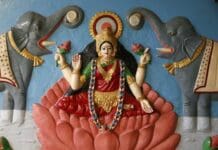When a life-size skeleton dressed like the Grim Reaper first appeared on a street altar in Tepito, Mexico City, in 2001, many passersby instinctively crossed themselves. The figure was La Santa Muerte – or Holy Death – a female folk saint cloaked in mystery and controversy that had previously been known, if at all, as a figure of domestic devotion: someone they might address a prayer to, but in the privacy of their home.
She personifies death itself and is often depicted holding a scythe or globe. And since the early 2000s, her popularity has steadily spread across Mexico and the Americas, Europe and beyond.
The idea and image of death made into a saint is both unthinkable and magnetic. Her association with drug traffickers and criminal rituals makes many people wary of the skeletal figure. La Santa Muerte also faces significant opposition from the Catholic Church, which condemns her veneration as heretical and morally dangerous. High-ranking church figures such as Cardinal Norberto Rivera Carrera in Mexico have publicly denounced her devotion, warning that it promotes superstition and goes against Christian values.
This criticism highlights a profound tension between official religion and the grassroots devotion. Many Mexicans who feel abandoned by government and church institutions embrace her as a source of hope. Indeed, based on my research, La Santa Muerte represents strength, protection and comfort to her devotees, which include prisoners, police officers, sex workers, LGBTQ+ people, migrants, the working class and others among less vulnerable populations. Despite her fearsome appearance, she offers a form of care they are often denied elsewhere.
As an anthropologist who has studied La Santa Muerte in Mexico, I believe her power reflects a paradoxical Mexican understanding of death – not only as a symbol of fear but as an intimate part of everyday life that has become one of resilience and resistance amid the country’s chronic violence.
In my recent book, “The Intimacy of Images,” I examine how devotion to La Santa Muerte in Oaxaca – the state famed for its Day of the Dead tradition – draws on Mexico’s long-standing, often playful relationship with the image of death.
Based on over a decade of ethnographic fieldwork, I found how people’s prayers, offerings and promises to her are part of a desire for solutions to everyday problems such as illness, economic hardship and protection from harm. Her frequent representation in images such as altars, tattoos and artistic productions also reflects an evolving social understanding of death that has long been a pervasive symbol of Mexican culture, identity and the power of the state.
Following the Mexican Revolution in the early 20th century, death as a symbol of the new Mexican nation was popularized by artists such as José Guadalupe Posada, especially through La Catrina, the caricature of the dandy skeleton often associated with the Day of the Dead. Whereas death and its personification were once part of an ethos of celebration and fearlessness in the face of death, they have now become disturbing reminders of the mounting insecurity and violence in Mexico.
This transformation, and the role the skeletal saint plays in providing protection in this dangerous context, reflects Mexico’s broader descent into turmoil. In the 2000 national elections, the Institutional Revolutionary Party was unseated after 71 years of uninterrupted rule. The election of the conservative National Action Party, or PAN, in its place saw the fracturing of informal alliances between the state and criminal networks that had previously tamped down on crime through systems of patronage.
In 2006, newly elected PAN President Felipe Calderón launched a militarized war on crime after the yearslong evolution of these early criminal networks into ruthless organizations.
In the following decades, cartel violence has surged, civilian deaths and femicides have escalated, and state institutions have been accused of either direct complicity or a refusal to intervene. The 2014 disappearance of 43 students in Iguala – a case that revealed the degree of state and criminal organizations’ collusion and remains unresolved – only crystallized public outrage. Such rampant violence continues to this day.
Since the beginning of the Mexican drug war in 2006, an estimated 460,000 people have been murdered, and more than 115,000 people are officially listed as missing in the country – roughly one in every 1,140 residents. In heavily affected states such as Guerrero and Jalisco, that ratio is likely far higher, revealing the uneven geography of violence and disappearance across the country.
Claudia Sheinbaum, the country’s first female president – who took office in October 2024 – has promised to dismantle organized crime. Yet the violence and widespread public perceptions of insecurity persist.
For most devotees, La Santa Muerte is not an ally of the criminals, despite its use by cartel-linked groups. Instead, she is one of the few remaining forms of help amid a terrifying social reality. She offers no illusion that the situation of political dysfunction or rampant violence will improve – only presence and protection. Her image reflects a brutal truth: Survival is no longer guaranteed by a state whose ties to the cartels run deep.
This political and spiritual vacuum is seen in the rise of other lay figures of devotion – folk saints such as Jesús Malverde, more official ones such as San Judas Tadeo, or even devotion to the devil.
La Santa Muerte is distinct, however. She is death personified, the end of life, the ultimate judge and a symbol of shared mortality, regardless of status, race or gender. As one devotee told me: “If you open us, you’ll find the same bones.” La Santa Muerte is also imbued with care and love by her followers. Some address her as kin, an aunt or a revered mother incarnating maternal protection and a kind of strength more commonly associated with the masculine. As many say: “She’s a badass.”
In a country where state protection is scarce and the boundaries between authorities and cartels blur, she represents the people and also shields her believers through miraculous protection. Her followers turn to her because, as they say, only death can protect them from death.
Given her devotees’ vulnerability and the wholehearted trust they place in their skeletal saint, La Santa Muerte is more than mere folklore. She is the patron saint of the many in a country where death walks close. She is a figure of personal solace and collective resilience. Above all, she is a mirror – reflecting a society in crisis and engulfed in violence, and a people reaching for meaning, dignity and protection in the face of it all.
This article is republished from The Conversation, a nonprofit, independent news organization bringing you facts and trustworthy analysis to help you make sense of our complex world. It was written by: Myriam Lamrani, Harvard University
Read more: Day of the Dead is taking on Halloween traditions, but the sacred holiday is far more than a ‘Mexican Halloween’ How ‘La Catrina’ became the iconic symbol of Day of the Dead How the Day of the Dead is being used to protest violence against women
Myriam Lamrani does not work for, consult, own shares in or receive funding from any company or organization that would benefit from this article, and has disclosed no relevant affiliations beyond their academic appointment.














